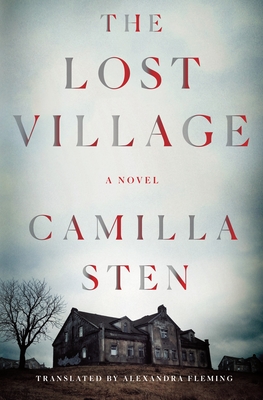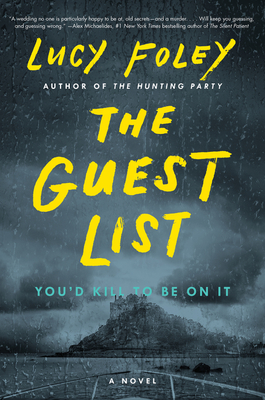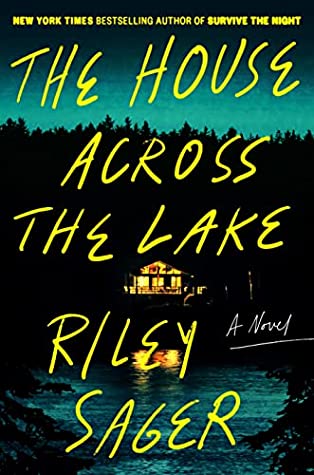
TL;W[on’t]R[ead the review]: Some really nice atmosphere and a great premise marred by a VERY ham-fisted approach to mental illness and intellectual disability. Proceed with caution.
Content warnings: off-page rape, childbirth (from rape), murder by stoning, gaslighting, ableism (mostly challenged), arson, lots of murder, cults
Summary [courtesy of Goodreads]: Documentary filmmaker Alice Lindstedt has been obsessed with the vanishing residents of the old mining town, dubbed “The Lost Village,” since she was a little girl. In 1959, her grandmother’s entire family disappeared in this mysterious tragedy, and ever since, the unanswered questions surrounding the only two people who were left—a woman stoned to death in the town center and an abandoned newborn—have plagued her. She’s gathered a small crew of friends in the remote village to make a film about what really happened. But there will be no turning back. Not long after they’ve set up camp, mysterious things begin to happen. Equipment is destroyed. People go missing. As doubt breeds fear and their very minds begin to crack, one thing becomes startlingly clear to Alice: They are not alone. They’re looking for the truth…But what if it finds them first?
Um.
Y’all. I WANTED to love this book. I went in excited as hell by the premise. (YAY isolated ghost town, YAY modern film crew, YAY woman MC, YAY horror elements, bring on the ghosts and demons!) I was also ‘excited,’ though that’s not really the right word or sentiment, by the author’s opening note about ableism, mental illness, depression, and the intersectional real-world horror that historically has emerged when people raised and socialized as girls and women have mental illnesses or are neurodivergent. So I was prepared for this to be a heavy book sometimes, but I was still hoping for a good time.
But oh god. I mean, YES, it was a good time some of the time, particularly if you’re able to overlook some glaring issues with disability rep., but those things (along with the ridiculously silly, unbelievable ending) did seriously hamper my reading experience. In the end, Birgitta’s character (the intellectually disabled woman found flogged to death in the description on the cover) seemed to exist primarily to show how evil people can be, which…we know?!?! We know this in general (hello history, hello any random Twitter feed this instant), and we certainly know this in a horror-thriller, without needing to have it illustrated in what frankly seemed like a gratuitous, excessive way. It was misery porn, and, at times by the end, it was torture porn (albeit less graphically rendered than other horror stories can be).
I’m also pretty sure, partly because of the author’s note and partly based on some plot reveals, that the author is (unintentionally or not) trying to lump all mental illnesses and intellectual disabilities AND potential neurodivergences under one umbrella, an umbrella she feels qualified to speak about due to her own self-disclosed depression. That’s…a problematic reach, particularly when it comes to Birgitta’s nonverbal status, her self-inflicted violence, and her intellectual disability. Birgitta remains the ultimate victim in some ways, with very little interiority (more on this in a second). She’s mostly a plot device to generate much of the horror both within the world of the novel and for the reader. (Also, even our sympathetic modern point-of-view character Alice pityingly thinks of her as a “child trapped in a grown woman’s body,” which, hello cliched ableism, it’s so shitty to see you here.) Any more gets into
SPOILER TERRITORY
Ok, so, I think the novel DOES try to give Birgitta a more direct point of view during a few key moments, but they’re steeped in the supernatural in ways that most other characters don’t have to grapple with. (Or, at least, the other characters get to say their say without the aid of magic.) Birgitta is able to communicate somewhat via drawing, and her drawings DO emerge as key clues to her murder and the mystery of how the town descended into cult-driven hysteria, but they’re already ‘spooky’ to the MC when she notices the huge, gaping mouths of all the drawn figures. And then Tone (poor, poor Tone, who deserved SO MUCH MORE than this book was willing to give her) starts to trace and create similar figures when she becomes terrified and nonverbal. This leads main character Alice to discover that Tone thinks she’s Birgitta, who turns out to be Tone’s grandmother. (Birgitta was raped by the evil preacher in the ‘50s as the catalyst for some bizarre and heinous plan to scapegoat her as a witch once she delivered the child who was the product of that rape. [If you are confused, that makes sense, because THIS doesn’t really make sense.] While Birgitta was stoned to death, the baby survived because of reasons, and Tone is the baby’s daughter, though she doesn’t know her full genealogy.)
It turns out, though, that Tone probably IS Birgitta in these moments–meaning she’s being possessed by her grandmother. Tone has always suffered from major depressive disorder and, prior to the start of the book, she had a hallucinatory breakdown (that might not have been all that hallucinatory?) in which she thought she was her grandmother and that she was in the ghost town itself. Having recovered, she was eager to actually visit the town. Once there, she goes off her meds in order to take painkillers for a broken ankle, and she suffers another mental break. She then disappears, the crew’s vans get blown up, and they start freaking out and decide she must be responsible, since she has a mental illness. Alice tries to defend her friend to no avail. (Sidebar: the reaction of the rest of the film crew to finding Tone’s prescription–Abilify [gasp!!]–was absurd. It’s a goddamn mood stabilizer and antipsychotic, not a smoking gun, and while I realize Sten’s point was ABOUT the ableism of others, it was still pretty shitty to see the old cliche about ‘being off her meds’ used here.)
As actual murders of the crew start to happen, the remaining few believe Tone is responsible (even though throughout the earlier sections EACH character has seen a shadowy figure and freaked out that they’re ‘not alone.’ NO ONE is smart in this. NO ONE.) Of course it’s not Tone (that’s pretty clearly telegraphed as a nod to the dangers of ableism and bigoted assumptions), but Tone’s gone full-on Birgitta by this point. The novel never comes out and says it’s possession (in the same way it never fully confronts the numerous supernatural things that are clearly going on and HAVE to be operating for any of the ending to even begin to make sense), but it’s pretty obvious. But this has the (possibly unintentional) effect of rendering a sporadic symptom of Tone’s major depressive disorder as supernatural ITSELF. Yes, she could just be a depressed woman who also happens to be a vehicle for her grandmother, but the book doesn’t really open up that option. Instead, the focus is on the link between her depression and her psychosis, meaning if one is supernatural the other is tinged with it too. And that’s…weird? At the same time, Alice constantly worries about her own depression (which seemed to be situational) in an attempt to empathize with the gaslighting that women experience, but really she just wonders whether she could be hallucinating things like Tone, since they both have depression (“Was it all in my head? I’ve never experienced psychosis, not like Tone. But her symptoms started as depression, and that I have had…”)…Again, the messaging in this book when it comes to mental illness or disability is a MESS.
When the reveal of what happened to the rest of the town comes, I found it fittingly anticlimactic. The evil preacher led them all underground to the newly closed mines (WHY no one checked the mines afterwards to look for hundreds of disappeared people is fucking beyond me). He planned on killing a few of the rebellious women (“Down here I am God.”) before leading his flock back above ground. However, at the last minute, the cavernous area caves in and they all die. Apparently, I wasn’t alone in cracking up at this, as our past-POV character (Alice’s great-grandmother) muses: “How funny.”
But then she continues, “The muffled roar of the rocks above them sounds just like Birgitta.” Now HERE’s something I can get behind: the murdered nonverbal woman getting revenge on the entire town who murdered her, not via a direct haunting but by instantiating her bellowing voice into the very land that raised her. Hers is the ultimate empowered speech act here, and her bellow is not failed communication but clear and assertive command. That her vengeance happens posthumously SUCKS hard (as does the fact that this violence cannot save her would-be rescuer, Alice’s great-grandmother), but it’s a powerful and empowering moment nonetheless. It doesn’t undo the huge problems that Birgitta’s representation creates in the novel, though (and I’d imagine many read this moment as more de-humanizing than empowering, which I can understand but disagree with).
The rest of the book, though…the modern timeline ending itself was just so unbelievable, I was dying laughing. Apparently, a ride-or-die cult woman (Alice’s great-aunt) who has to be at least 75 years old has survived in the ghost town (which hadn’t been visited by ANYONE other than a survey crew briefly in the 1990s, between 1959 and NOW), thrived, and is strong and stealthy enough to choke a woman to death with her bare hands, bludgeon a strong dude with a honey jar, and almost kill literally everyone else. I…what? There is no sense to be made here. None at all.
Copaganda rating: Negligible–the past timeline has some cops discovering the town and poor Birgitta’s body, but it’s brief and they do nothing useful (see never investigating the mine for the townspeople’s bodies).



